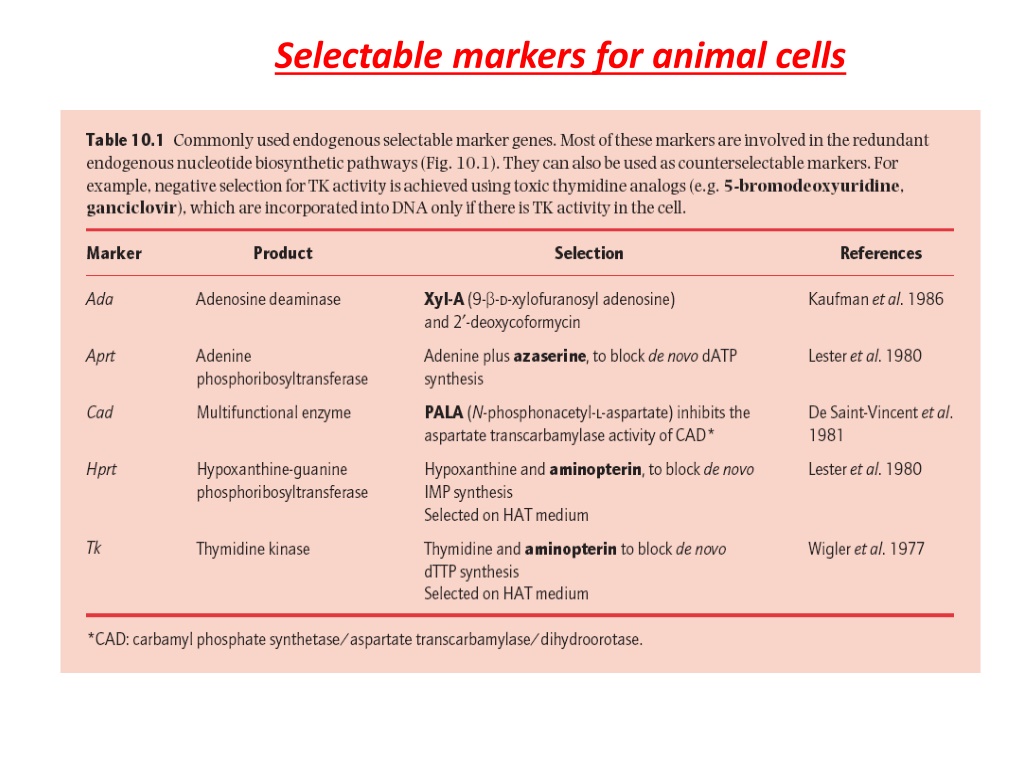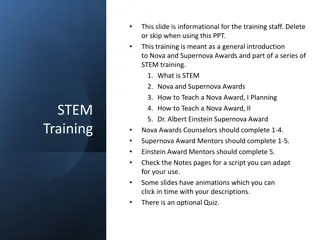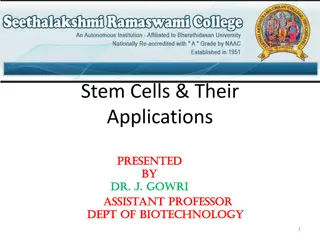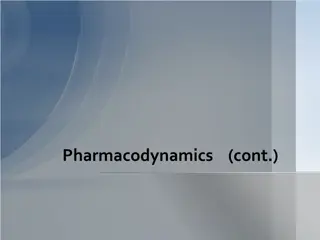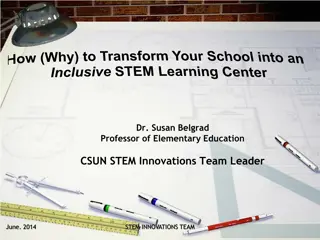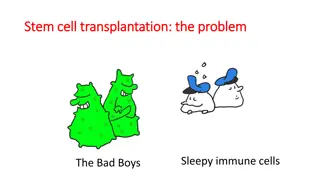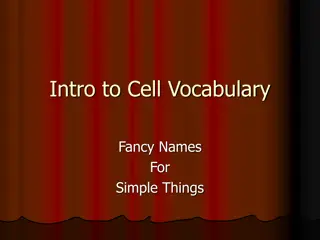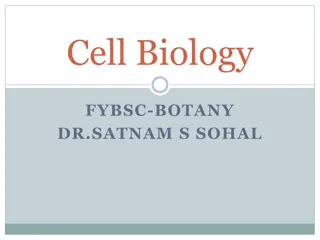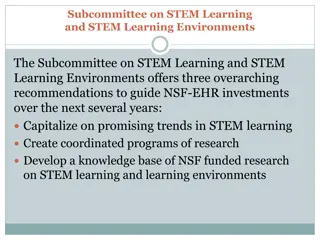Understanding Stem Cells and Cell Potency in Animal Cells
Stem cells play a crucial role in animal cells, offering the potential to differentiate into various cell types. Totipotent stem cells are the most versatile, capable of developing into any cell type in the embryo, including extra-embryonic cells. Pluripotent stem cells can give rise to all body cell types except the placenta, while multipotent stem cells have limited differentiation potential within specific lineages. The hierarchy of cell potency showcases the developmental stages of these stem cells, highlighting their unique characteristics and applications in research and therapy.
Download Presentation

Please find below an Image/Link to download the presentation.
The content on the website is provided AS IS for your information and personal use only. It may not be sold, licensed, or shared on other websites without obtaining consent from the author. Download presentation by click this link. If you encounter any issues during the download, it is possible that the publisher has removed the file from their server.
E N D
Presentation Transcript
For practical reasons, i.e., their small size and low cost of housing in comparison to that for larger vertebrates, their short generation time, and their fairly well defined genetics, mice have become the main species used in the field of transgenics.
Stem cells are cells that can divide into multiple kinds of other cells. Stem cells are formed and differentiate during early embryonic development, and are also a natural part of the tissue renewal processes throughout life. Totipotent, Pluripotent, and Multipotent Stem cells The key differences between these cells are: 1. When each appears during the process of human development. 2. Their degree of flexibility to become other cell types. The key similarity is that all three of these cells types are characterized by self- renewal and the capacity to turn into into mature cell types. Together, they form the 200+ cell types that create a human being.
Hierarchy of cell potency Totipotent stem cells Totipotent (omnipotent) stem cells can give rise to any of the 220 cell types found in an embryo as well as extra-embryonic cells (placenta). Totipotent Stem Cells Totipotent stem cells are the most versatile stem cell type, because they are formed shortly after fertilization of an egg cell by a sperm cell. They can become all of the cells of the human body, as well as the cells of the embryo and developing fetus. At about four days into development, these totipotent cells specialize slightly, becoming pluripotent stem cells. Pluripotent stem cells Pluripotent stem cells can give rise to all cell types of the body (but not the placenta). Embryonic stem cells are controversial, because they are collected from early-stage embryos. iPS cells are not controversial, because they are made from adult cells. iPS cells are differentiated cells that are reprogrammed back into an embryonic-like state. They are usually created from skin or blood cells.
Multipotent stem cells Multipotent stem cells can develop into a limited number of cell types in a particular lineage. For example: Hematopoietic stem cells (HSCs) are a type of multipotent stem cell that prefer to become cells of the blood and immune system, although it it possible to induce them to become other cell types. Mesenchymal stem cells (MSCs) are a type of multipotent stem cell found in bone marrow and fat, among other tissues. Theses cells tend to turn into bone, fat, muscle and cartilage cells. Neural stem cells are a type of multipotent stem cells found in the brain. Unsurprisingly, they like to differentiate into neurons, glia, and other similar cells.
Totipotent High Pluripotent Medium Multipotent Low Relative potency Cell types capable of generating Differentiate into any cell type Differentiate into cells from any of the three germ layers Differentiate into a limited range of cell types Terminology Toti = Whole Pluri = Many Multi = Several Examples Zygote, early morula Embryonic stem cells, Induced pluripotent stem cells Hematopoietic stem cells, neural stem cells, mesenchymal stem cells Found Early cells of fertilized egg +++ Inner mass cells of the blastocyst ++ In many tissues Expression of pluripotency genes Expression of lineage- specific genes + + ++ +++ Pros of use in research Easy to isolate and Easy to isolate and grow Less ethical issues, less chance of immune rejection if taken from same patient grow Cons of use in research Ethical issues Ethical issues, teratoma formation Hard to isolate, limited differentiation, scarce
Methods of creation of transgenic animals A. Retrovirus-mediated gene transfer (Introduction of retroviral vectors in the cells of an early stage embryo) B. Pronuclear Microinjection (Microinjection of DNA into the male pro-nucleus of one cell embryos) C. Embryonic stem cell-mediated gene transfer (Introduction of genetically engineered embryonic cells into early stage developing embryo)
1. A gene knockout (abbreviation: KO) is a genetic technique in which one of an organism's genes is made inoperative ("knocked out" of the organism). Knockout organisms or simply knockouts are used to study gene function, usually by investigating the effect of gene loss. Researchers draw inferences from the difference between the knockout organism and normal individuals. 2. Gene knockin (KI) is the process of targeted insertion of an exogenous gene at a specific locus in the genome. The difference between knock-in technology and traditional transgenic techniques is that a knock-in involves a gene inserted into a specific locus, and is thus a "targeted" insertion. 3. Gene knockdown - reduce the levels of expression of a gene in your cell. This is not as dramatic as a gene knockout, and there may still be some expression of your gene.
TheTP53 gene is located on the long arm of chromosome 17 and contains 11 exons spanning some 20 000 bp of genomic sequence. BRCA1/BRCA2 genes p53 gene Tumor suppressor genes KO mice will develop tumor in between 3 and 6 months.
Transgenic animal In 1974 Rudolf Jaenisch created a transgenic mouse by introducing foreign DNA into its embryo, making it the world's first transgenic animal. Mice with genes knocked out (knockout mouse) were created in 1989. The first genetically modified animal to be commercialised was the GloFish, a Zebra fish with a fluorescent gene added that allows it to glow in the dark under ultraviolet light.It was released to the US market in 2003. The first genetically modified animal to be approved for food use was AquAdvantage salmon in 2015.
The first genetically modified animal to be commercialized was the GloFish, a Zebra fish with a fluorescent gene added that allows it to glow in the dark under ultraviolet light.It was released to the US market in 2003.
The first genetically modified cow (in year 1997) or transgenic cow was Rosie. Rosie was able to produce milk enriched in the human protein. The milk was rich in human alpha-lactalbumin which was a more suitable product for human baby consumption than normal milk.
Tracy (1990 1997) was a transgenically modified sheep created by scientists at Scotland's Roslin Institute to produce the human protein alpha 1-antitrypsin, a substance regarded in the 1990s as a potential pharmaceutical for the treatments of cystic fibrosis and emphysema. Notably, she is the first transgenic farm mammal ever created.[2]
ANDi is the first genetically modified rhesus monkey, who was born at Oregon Health Sciences University on October 1, 2001. OHSU named the monkey ANDi because .. it stands for iDNA spelled backward. The work demonstrates that a foreign gene can be delivered and inserted into a primate chromosome. Gene = GFP
Animal cloning Dolly was a female Finnish Dorset sheep and the first mammal cloned from an adult somatic cell. She was cloned by associates of the Roslin Institute in Scotland, using the process of nuclear transfer from a cell taken from a mammary gland. (1996 to 2003)
